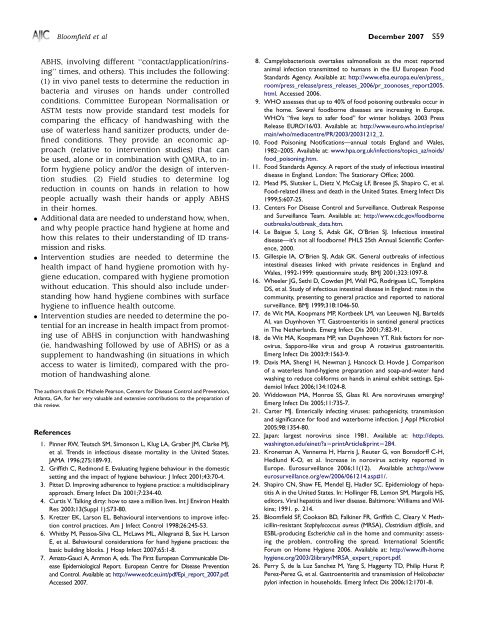The effectiveness of hand hygiene procedures in reducing the risks ...
The effectiveness of hand hygiene procedures in reducing the risks ...
The effectiveness of hand hygiene procedures in reducing the risks ...
You also want an ePaper? Increase the reach of your titles
YUMPU automatically turns print PDFs into web optimized ePapers that Google loves.
Bloomfield et al December 2007 S59dddABHS, <strong>in</strong>volv<strong>in</strong>g different ‘‘contact/application/r<strong>in</strong>s<strong>in</strong>g’’times, and o<strong>the</strong>rs). This <strong>in</strong>cludes <strong>the</strong> follow<strong>in</strong>g:(1) <strong>in</strong> vivo panel tests to determ<strong>in</strong>e <strong>the</strong> reduction <strong>in</strong>bacteria and viruses on <strong>hand</strong>s under controlledconditions. Committee European Normalisation orASTM tests now provide standard test models forcompar<strong>in</strong>g <strong>the</strong> efficacy <strong>of</strong> <strong>hand</strong>wash<strong>in</strong>g with <strong>the</strong>use <strong>of</strong> waterless <strong>hand</strong> sanitizer products, under def<strong>in</strong>edconditions. <strong>The</strong>y provide an economic approach(relative to <strong>in</strong>tervention studies) that canbe used, alone or <strong>in</strong> comb<strong>in</strong>ation with QMRA, to <strong>in</strong>form<strong>hygiene</strong> policy and/or <strong>the</strong> design <strong>of</strong> <strong>in</strong>terventionstudies. (2) Field studies to determ<strong>in</strong>e logreduction <strong>in</strong> counts on <strong>hand</strong>s <strong>in</strong> relation to howpeople actually wash <strong>the</strong>ir <strong>hand</strong>s or apply ABHS<strong>in</strong> <strong>the</strong>ir homes.Additional data are needed to understand how, when,and why people practice <strong>hand</strong> <strong>hygiene</strong> at home andhow this relates to <strong>the</strong>ir understand<strong>in</strong>g <strong>of</strong> ID transmissionand <strong>risks</strong>.Intervention studies are needed to determ<strong>in</strong>e <strong>the</strong>health impact <strong>of</strong> <strong>hand</strong> <strong>hygiene</strong> promotion with <strong>hygiene</strong>education, compared with <strong>hygiene</strong> promotionwithout education. This should also <strong>in</strong>clude understand<strong>in</strong>ghow <strong>hand</strong> <strong>hygiene</strong> comb<strong>in</strong>es with surface<strong>hygiene</strong> to <strong>in</strong>fluence health outcome.Intervention studies are needed to determ<strong>in</strong>e <strong>the</strong> potentialfor an <strong>in</strong>crease <strong>in</strong> health impact from promot<strong>in</strong>guse <strong>of</strong> ABHS <strong>in</strong> conjunction with <strong>hand</strong>wash<strong>in</strong>g(ie, <strong>hand</strong>wash<strong>in</strong>g followed by use <strong>of</strong> ABHS) or as asupplement to <strong>hand</strong>wash<strong>in</strong>g (<strong>in</strong> situations <strong>in</strong> whichaccess to water is limited), compared with <strong>the</strong> promotion<strong>of</strong> <strong>hand</strong>wash<strong>in</strong>g alone.<strong>The</strong> authors thank Dr. Michele Pearson, Centers for Disease Control and Prevention,Atlanta, GA, for her very valuable and extensive contributions to <strong>the</strong> preparation <strong>of</strong>this review.References1. P<strong>in</strong>ner RW, Teutsch SM, Simonson L, Klug LA, Graber JM, Clarke MJ,et al. Trends <strong>in</strong> <strong>in</strong>fectious disease mortality <strong>in</strong> <strong>the</strong> United States.JAMA 1996;275:189-93.2. Griffith C, Redmond E. Evaluat<strong>in</strong>g <strong>hygiene</strong> behaviour <strong>in</strong> <strong>the</strong> domesticsett<strong>in</strong>g and <strong>the</strong> impact <strong>of</strong> <strong>hygiene</strong> behaviour. J Infect 2001;43:70-4.3. Pittet D. Improv<strong>in</strong>g adherence to <strong>hygiene</strong> practice: a multidiscipl<strong>in</strong>aryapproach. Emerg Infect Dis 2001;7:234-40.4. Curtis V. Talk<strong>in</strong>g dirty: how to save a million lives. Int J Environ HealthRes 2003;13(Suppl 1):S73-80.5. Kretzer EK, Larson EL. Behavioural <strong>in</strong>terventions to improve <strong>in</strong>fectioncontrol practices. Am J Infect Control 1998;26:245-53.6. Whitby M, Pessoa-Silva CL, McLaws ML, Allegranzi B, Sax H, LarsonE, et al. Behavioural considerations for <strong>hand</strong> <strong>hygiene</strong> practices: <strong>the</strong>basic build<strong>in</strong>g blocks. J Hosp Infect 2007;65:1-8.7. Amato-Gauci A, Ammon A, eds. <strong>The</strong> First European Communicable DiseaseEpidemiological Report. European Centre for Disease Preventionand Control. Available at: http://www.ecdc.eu.<strong>in</strong>t/pdf/Epi_report_2007.pdf.Accessed 2007.8. Campylobacteriosis overtakes salmonellosis as <strong>the</strong> most reportedanimal <strong>in</strong>fection transmitted to humans <strong>in</strong> <strong>the</strong> EU European FoodStandards Agency. Available at: http://www.efsa.europa.eu/en/press_room/press_release/press_releases_2006/pr_zoonoses_report2005.html. Accessed 2006.9. WHO assesses that up to 40% <strong>of</strong> food poison<strong>in</strong>g outbreaks occur <strong>in</strong><strong>the</strong> home. Several foodborne diseases are <strong>in</strong>creas<strong>in</strong>g <strong>in</strong> Europe.WHO’s ‘‘five keys to safer food’’ for w<strong>in</strong>ter holidays. 2003 PressRelease EURO/16/03. Available at: http://www.euro.who.<strong>in</strong>t/eprise/ma<strong>in</strong>/who/mediacentre/PR/2003/20031212_2.10. Food Poison<strong>in</strong>g Notifications—annual totals England and Wales,1982–2005. Available at: www.hpa.org.uk/<strong>in</strong>fections/topics_az/noids/food_poison<strong>in</strong>g.htm.11. Food Standards Agency. A report <strong>of</strong> <strong>the</strong> study <strong>of</strong> <strong>in</strong>fectious <strong>in</strong>test<strong>in</strong>aldisease <strong>in</strong> England. London: <strong>The</strong> Stationary Office; 2000.12. Mead PS, Slutsker L, Dietz V, McCaig LF, Bresee JS, Shapiro C, et al.Food-related illness and death <strong>in</strong> <strong>the</strong> United States. Emerg Infect Dis1999;5:607-25.13. Centers For Disease Control and Surveillance. Outbreak Responseand Surveillance Team. Available at: http://www.cdc.gov/foodborneoutbreaks/outbreak_data.htm.14. Le Baigue S, Long S, Adak GK, O’Brien SJ. Infectious <strong>in</strong>test<strong>in</strong>aldisease—it’s not all foodborne! PHLS 25th Annual Scientific Conference,2000.15. Gillespie IA, O’Brien SJ, Adak GK. General outbreaks <strong>of</strong> <strong>in</strong>fectious<strong>in</strong>test<strong>in</strong>al diseases l<strong>in</strong>ked with private residences <strong>in</strong> England andWales, 1992-1999: questionnaire study. BMJ 2001;323:1097-8.16. Wheeler JG, Sethi D, Cowden JM, Wall PG, Rodrigues LC, Tompk<strong>in</strong>sDS, et al. Study <strong>of</strong> <strong>in</strong>fectious <strong>in</strong>test<strong>in</strong>al disease <strong>in</strong> England: rates <strong>in</strong> <strong>the</strong>community, present<strong>in</strong>g to general practice and reported to nationalsurveillance. BMJ 1999;318:1046-50.17. de Wit MA, Koopmans MP, Kortbeek LM, van Leeuwen NJ, BarteldsAI, van Duynhoven YT. Gastroenteritis <strong>in</strong> sent<strong>in</strong>el general practices<strong>in</strong> <strong>The</strong> Ne<strong>the</strong>rlands. Emerg Infect Dis 2001;7:82-91.18. de Wit MA, Koopmans MP, van Duynhoven YT. Risk factors for norovirus,Sapporo-like virus and group A rotavirus gastroenteritis.Emerg Infect Dis 2003;9:1563-9.19. Davis MA, Sheng1 H, Newman J, Hancock D, Hovde J. Comparison<strong>of</strong> a waterless <strong>hand</strong>-<strong>hygiene</strong> preparation and soap-and-water <strong>hand</strong>wash<strong>in</strong>g to reduce coliforms on <strong>hand</strong>s <strong>in</strong> animal exhibit sett<strong>in</strong>gs. EpidemiolInfect 2006;134:1024-8.20. Widdowson MA, Monroe SS, Glass RI. Are noroviruses emerg<strong>in</strong>g?Emerg Infect Dis 2005;11:735-7.21. Carter MJ. Enterically <strong>in</strong>fect<strong>in</strong>g viruses: pathogenicity, transmissionand significance for food and waterborne <strong>in</strong>fection. J Appl Microbiol2005;98:1354-80.22. Japan: largest norovirus s<strong>in</strong>ce 1981. Available at: http://depts.wash<strong>in</strong>gton.edu/e<strong>in</strong>et/?a5pr<strong>in</strong>tArticle&pr<strong>in</strong>t5284.23. Kroneman A, Vennema H, Harris J, Reuter G, von Bonsdorff C-H,Hedlund K-O, et al. Increase <strong>in</strong> norovirus activity reported <strong>in</strong>Europe. Eurosurveillance 2006;11(12). Available at:http://wwweurosurveillance.org/ew/2006/061214.asp#1/.24. Shapiro CN, Shaw FE, Mendel EJ, Hadler SC. Epidemiology <strong>of</strong> hepatitisA <strong>in</strong> <strong>the</strong> United States. In: Holl<strong>in</strong>ger FB, Lemon SM, Margolis HS,editors. Viral hepatitis and liver disease. Baltimore: Williams and Wilk<strong>in</strong>s;1991. p. 214.25. Bloomfield SF, Cookson BD, Falk<strong>in</strong>er FR, Griffith C, Cleary V. Methicill<strong>in</strong>-resistantStaphylococcus aureus (MRSA), Clostridium difficile, andESBL-produc<strong>in</strong>g Escherichia coli <strong>in</strong> <strong>the</strong> home and community: assess<strong>in</strong>g<strong>the</strong> problem, controll<strong>in</strong>g <strong>the</strong> spread. International ScientificForum on Home Hygiene 2006. Available at: http://www.ifh-home<strong>hygiene</strong>.org/2003/2library/MRSA_expert_report.pdf.26. Perry S, de la Luz Sanchez M, Yang S, Haggerty TD, Philip Hurst P,Perez-Perez G, et al. Gastroenteritis and transmission <strong>of</strong> Helicobacterpylori <strong>in</strong>fection <strong>in</strong> households. Emerg Infect Dis 2006;12:1701-8.


